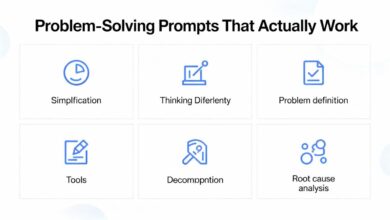
Look, I will be honest, I spent way too long thinking ChatGPT was overhyped because I kept getting mediocre results. Turns out I was just asking the wrong questions.
After months of tinkering (and probably annoying my coworkers by constantly sharing wait, check this out), I have landed on 50 prompt frameworks that consistently deliver. They are a bit unconventional, but that is kind of the point.
1. The Chain-of-Thought Breakdown
Force ChatGPT to show its work before jumping to conclusions:
Walk me through solving [problem] step-by-step. For each step, explain your reasoning before moving to the next one. If you make any assumptions, state them explicitly. Only provide your final answer after completing all steps.
Example: Walk me through whether I should buy or lease a car for my business, step-by-step. Explain your reasoning at each step and state any assumptions. Provide your final recommendation only at the end.
The magic here: You catch flawed logic early instead of getting a confident-sounding answer that is built on shaky assumptions. Plus, you actually learn the thinking process, not just the conclusion.
2. The Perspective Shift Generator
When you are too close to a problem and need fresh angles:
Describe [situation/problem] from three completely different perspectives: an optimist, a pessimist, and a pragmatist. For each perspective, identify what they would prioritize and what solution they would propose. Then tell me which perspective is most useful for my context.
Example: Describe launching a paid newsletter from three perspectives: optimist, pessimist, pragmatist. What would each prioritize? Which perspective is most useful for someone with a small but engaged audience?
The magic here: Breaks you out of tunnel vision. Sometimes the pessimist concerns are exactly what you needed to hear. Sometimes the optimist reveals opportunities you have been blind to.
3. The Template Extractor
Reverse-engineer patterns from examples you like:
Analyze these [number] examples of [content type]. Identify the underlying structure, pattern, or formula they share. Create a reusable template based on this pattern, with placeholders I can fill in. Examples: [paste examples]
Example: Analyze these 3 viral Twitter threads. Identify the underlying structure they share and create a reusable template with placeholders. [paste threads]
The magic here: You are not copying – you are understanding WHY something works so you can apply that pattern to your own stuff. Works for emails, landing pages, presentations, whatever.
4. The Constraint-Based Creator
Turn limitations into creative fuel:
Generate [output] for [purpose], but you must work within these constraints: [list specific limitations]. Treat these constraints as non-negotiable requirements that should inspire creativity, not as obstacles. Explain how you worked within each constraint.
Example: Generate 3 content ideas for my productivity blog, but constraints: no listicles, must be under 800 words, cannot mention any productivity apps, must include a personal story. Explain how you addressed each constraint.
The magic here: Constraints force originality. Without them, you get the same generic suggestions everyone else gets. With them, you get ideas actually tailored to your unique situation.
5. The Pre-Mortem Analysis
Plan for failure before you start:
Imagine I have pursued [goal/project] and it completely failed six months from now. Working backwards, describe the most likely reasons it failed. For each reason, suggest one specific preventive measure I could implement now. Be brutally honest.
Example: Imagine I launched an online course and it completely flopped six months from now. Working backwards, what most likely went wrong? For each reason, suggest a preventive measure I could take now.
The magic here: You address fatal flaws in the planning stage instead of discovering them the hard way. It is like having a brutally honest friend who actually wants you to succeed.
6. The Devil’s Advocate
Challenge your own thinking before someone else does:
I believe [your position/idea]. Act as a devil’s advocate and present the strongest possible arguments against this position. Do not hold back or be diplomatic – I need the toughest counterarguments you can construct. Then rate how strong each counterargument is on a scale of 1-10.
Example: I believe starting a YouTube channel is the best way to grow my consulting business. Act as devil’s advocate and give me the strongest arguments against this. Rate each argument’s strength.
The magic here: You find the holes in your plan while you can still patch them. Better to get humbled by AI than by the market.
7. The Analogical Bridge
Explain complex ideas using unexpected comparisons:
Explain [complex topic] using an analogy from [unrelated field]. Make the connection clear and show how the analogy breaks down at certain points. This is for someone who understands [unrelated field] well but knows nothing about [complex topic].
Example: Explain blockchain technology using cooking analogies. Make it clear for someone who understands professional kitchens but knows nothing about blockchain. Show where the analogy breaks down.
The magic here: Forces you to understand concepts deeply enough to map them to something completely different. Plus, you get memorable explanations you can use with others.
Prompts From 8 to 50
Premium Content
Only for premium members. But, no worries, you’ve just stumbled on a little bonus. With a yearly pass at $4.99, you’ll have unlimited access to our full premium AI prompt library. Yes, for less than the cost of a coffee.
Read and AvailThe thing nobody tells you: ChatGPT is not a magic answer machine, but it is a thinking partner. The better you are at directing the conversation, the better your results.
Curious what other people have figured out. Drop your weirdest-but-effective prompts below.






